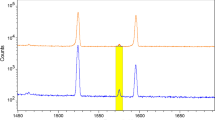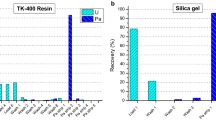Abstract
The quantification of uranium (U) by Kinetic Phosphorescence Analysis (KPA) is negatively impacted by the presence of silver (Ag). KPA can be combined with gamma spectroscopy to determine recovery of short-lived uranium isotopes after radiochemical purification in nuclear forensics relevant samples. Fission products can impact accurate gamma spectroscopy analysis. Removal of the 132Te fission product can be accomplished via deposition on a Ag disk. The purpose of this work is to determine the concentration of Ag that begins to quench the phosphorescent signal as part of sample purification scheme for U and the necessary steps for successful sample analysis via gamma spectroscopy and KPA.



Similar content being viewed by others
References
Morley SM, Seiner B, Finn E, Greenwood L, Smith SC, Gregory S, Haney M, Lucas D, Arrigo L, Beacham T (2015) Integrated separation scheme for measuring a suite of fission and activation products from a fresh mixed fission and activation product sample. J Radioanal Nucl Chem 304:509–515
Elliston J, Glover S, Filby R (2005) Comparison of direct kinetic phosphorescence analysis and recovery corrected kinetic phosphorescence analysis for the determination of natural uranium in human tissues. J Radioanal Nucl Chem 263:301–306
Douglas M, Friese J, Greenwood L, Farmer O, Thomas M, Maiti T, Finn E, Garofoli S, Gassman P, Huff M (2009) Separation and quantification of chemically diverse analytes in neutron irradiated fissile materials. J Radioanal Nucl Chem 282:63–68
Ramebäck H, Vesterlund A, Tovedal A, Nygren U, Wallberg L, Holm E, Ekberg C, Skarnemark G (2010) The jackknife as an approach for uncertainty assessment in gamma spectrometric measurements of uranium isotope ratios. Nucl Instrum Methods Phys. Res., Sect. B 268:2535–2538
IAEA Livechart-Table of Nuclides-Nuclear Structure and Decay Data.IAEA
Rosenberg BL, Shozugawa K, Steinhauser G (2015) Detection of Fuel Release in a Nuclear Accident: A Method for Preconcentration and Isolation of Reactor-Borne 239Np Using Ion-Specific Extraction Chromatography. Anal Chem 87:17: 8651–8656
Haney MM, Seiner BN, Finn EC, Friese JI (2016) Rapid quantitation of uranium from mixed fission product samples. J Radioanal Nucl Chem307:1737–1742
Seiner BN, King AR, Finn E, Greenwood LR, Metz LA, Friese J, Marsden O, Davies AV, Scivier P (2016) Fission product analysis of HEU irradiated within a boron carbide capsule: comparison of detection methodology at PNNL and AWE. J Radioanal Nucl Chem 307:1729–1734
Miley S, Hylden A, Friese J (2013) Resolution of uranium isotopes with kinetic phosphorescence analysis. J Radioanal Nucl Chem 296:923–925
Beck C, Seiner B, Smith S, Bowen J, Finch Z, Friese J (2016) Kinetic phosphorescence analysis to quantify europium and terbium. J Radioanal Nucl Chem 307:2187–2192
Sowder A, Clark S, Fjeld R (1998) The effect of sample matrix quenching on the measurement of trace uranium concentrations in aqueous solutions using kinetic phosphorimetry. J Radioanal Nucl Chem 234:257–260
Elliston J, Glover S, Filby R (2001) The determination of natural uranium in human tissues by recovery corrected kinetic phosphorescence analysis. J Radioanal Nucl Chem 248:487–491
Chemcheck (2006) Manual and Automatic Kinetic Phosphorescence Analyzer KPA-11. Operation Manual.
Smith R, Martell A, Motekaitis R (2004) NIST standard reference database 46. 2
Acknowledgements
This work was sponsored by the Office of the Deputy Assistant Secretary of Defense for Nuclear Matters. PNNL is operated by Battelle for the U.S. Department of Energy (DOE) under Contract No. DE-AC05-76RL0-1830. PNNL draws on signature capabilities in chemistry, earth sciences, and data analytics to advance scientific discovery and create solutions to the nation’s toughest challenges in energy resiliency and national security.
Author information
Authors and Affiliations
Corresponding author
Additional information
Publisher’s Note
Springer Nature remains neutral with regard to jurisdictional claims in published maps and institutional affiliations.
Rights and permissions
Springer Nature or its licensor (e.g. a society or other partner) holds exclusive rights to this article under a publishing agreement with the author(s) or other rightsholder(s); author self-archiving of the accepted manuscript version of this article is solely governed by the terms of such publishing agreement and applicable law.
About this article
Cite this article
Arnold, E., Uhnak, N., Schroeder, J. et al. The impact of silver on uranium quantification by kinetic phosphorescence analysis. J Radioanal Nucl Chem 331, 5167–5172 (2022). https://doi.org/10.1007/s10967-022-08574-w
Received:
Accepted:
Published:
Issue Date:
DOI: https://doi.org/10.1007/s10967-022-08574-w




